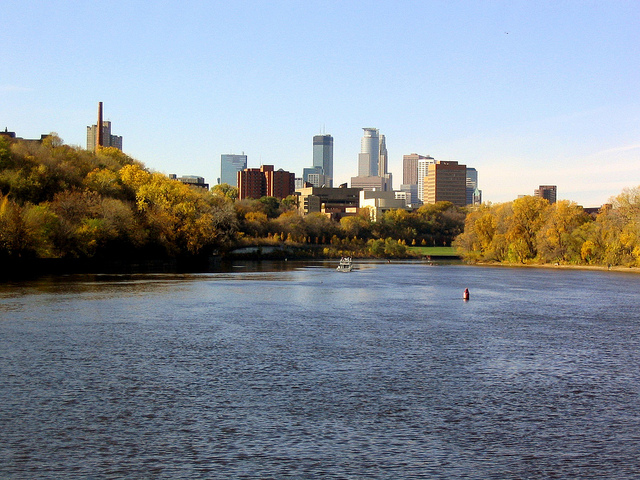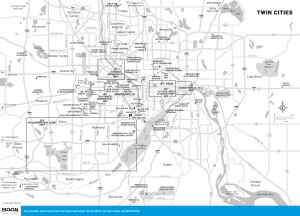
Minneapolis city skyline. Photo © Anthony Arrigo, licensed Creative Commons Attribution.

Twin Cities
With downtowns just eight miles apart, the Twin Cities moniker is certainly appropriate, but it is definitely a fraternal pairing. The English journalist Trevor Fishlock quipped that Minneapolis and St. Paul “are divided by the Mississippi River and united by the belief that the inhabitants of the other side of the river are inferior.” This tale of two cities no longer has the acrimony of the past, when census counts were illegally padded in an effort to outrank the other, but these friendly rivals have not completely lost their competitive edge: The two still go head-to-head to attract new businesses, and locals’ loyalties to one or the other run deep.While people who have never been here naturally lump the two together, visitors will quickly see the differences. Energetic Minneapolis with its soaring skyscrapers is the more modern and cosmopolitan of the two, while conservative St. Paul with its winding streets and downtown parks promotes its European charm. In a nutshell, Minneapolis is slick and St. Paul is sober—though ironically two of the most notable developments in recent years are the return of nightlife to downtown St. Paul and the historic restoration along Minneapolis’s riverfront. Citizens tend to reflect their cities’ demeanors. Some smug West Bank natives consider St. Paul nothing more than Minneapolis’s most enjoyable suburb, while St. Paulites sometimes judge their neighbors to be arrogant.
Despite all the differences, the many similarities best define the area. Twin Cities residents are full of hometown pride, prices are lower than in most similarly sized cities, and the quality of life here is second to none. Also, you don’t have to head out of town to enjoy the outdoors—the riverside parks are stunningly beautiful, especially as fall color takes hold, and around 800 of the state’s nearly 12,000 lakes wet the metro area.
While many locals find little reason to go “across the river,” exploring either city without at least a quick visit to the other would be a mistake. The combination of the best of both makes for a wonderful trip indeed.
You can’t do the Twin Cities justice in a day, and you’ll miss several highlights with only two, so let’s lay out a busy three-day visit with a home base in Minneapolis. On your first morning, do some people and sculpture watching along Nicollet Mall (come back in the early evening if you are here between Thanksgiving and Christmas, when Holidazzle parades light up the winter darkness) before admiring more statuary at the Minneapolis Sculpture Garden. Pick an art museum—the Walker Art Center if your tastes lean toward the contemporary or the Minneapolis Institute of Arts for the classics—and then stroll along the Mississippi Riverfront. For dinner, pick a country and cuisine from the dozens of choices along Eat Street and then enjoy a night of theater at the Guthrie Theater, Children’s Theatre Company, or one of the many respected smaller theaters.
On your second day, step back in time in St. Paul. Start out admiring the mansions lining Summit Avenue and tour the grandest of them all, the James J. Hill House. Also visit the Cathedral of St. Paul and take a quick trip through the Minnesota History Center before cruising the Mississippi River Mark Twainstyle with Padelford Riverboat Company (in the summer months). At the heart of downtown is Landmark Center, a castle-like cultural center best admired from Rice Park, which will be filled with ice sculptures if you are here during the Winter Carnival. Take a gander at St. Paul City Hall and Ramsey County Courthouse, Minnesota State Capitol, and the homes fronting the Irvine Park Historic District’s village green before heading back to Minneapolis for some nightlife, perhaps polkaing at Nye’s Polonaise or seeing who’s on stage at First Avenue, Dakota Jazz Club, or Cedar Cultural Center.
Everything on day three can be reached by light rail. On your way to a morning at Mall of America, stop for a look at the waterfall and historic buildings in Minnehaha Park. In the afternoon, watch costumed reenactors fire cannons at Historic Fort Snelling (a 15-minute walk from the light rail station) and then take a hike through the Minnesota River Valley in Fort Snelling State Park.
Excerpted from the Fourth Edition of Moon Minnesota.